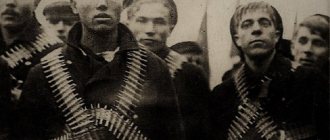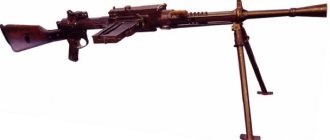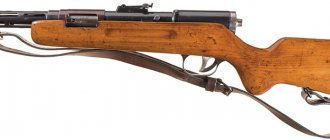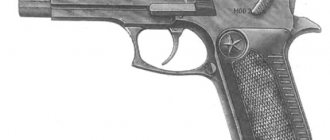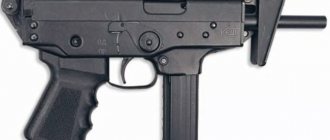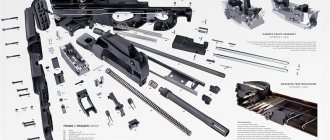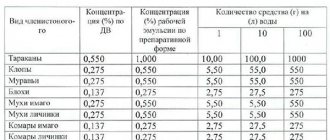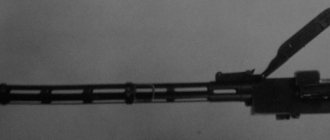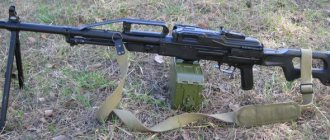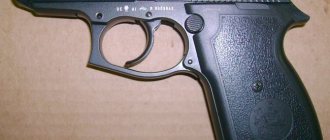| Danuvia 39.M / 43.M | |
| Type | submachine gun |
| A country | Kingdom of Hungary |
| Service history | |
| Years of use | from 1939 to 1950s |
| Adopted | 1943 |
| In service | Hungary |
| Wars and conflicts | The Second World War |
| Production history | |
| Designed by | 1930s |
| Years of production | 1939-1945 |
| Total issued | ~With wooden stock 2500 pcs., with folding wooden stock 2500 pcs., with metal shoulder rest 3000 pcs. |
| Options | 39.M - with a wooden butt; 39.M/A - with a folding wooden butt; 43.M - a modernized version with a folding metal shoulder rest. |
| Characteristics | |
| Weight, kg | 3.63 kg (without magazine) 4.46 kg (curb) |
| Length, mm | 953 / 749 |
| Barrel length, mm | 500 / 424 |
| Cartridge | 9×25 mm Mauser |
| Work principles | semi-free bolt with lever delayed recoil |
| Rate of fire, rounds/min | 750 |
| Initial bullet speed, m/s | 450-464 |
| Type of ammunition | 40-round box magazine |
Kiraly submachine gun
-
Kiraly 39.M
,
39 Minta
,
Géppisztoly 39M
,
Király géppisztoly - Hungarian.
Kiraly Geippista ,
Danuvia
is a submachine gun developed in the late 1930s by the Hungarian gunsmith designer Pál
Dedái Király
; aka
Paul D. Kiraly
, Paul or Pal Kiraly.
Sometimes it is mistakenly pronounced as “kiraly”, although the correct one is kirai, since the letter combination “ly” in the Hungarian language is read as “y” short.
It was adopted by the Hungarian army in 1939 under the designation 39.M and mass-produced at the Danuvia Gepgyar
.
In 1942-1943, a more compact model 43.M
, which had a folding stock and a shortened barrel.
Considering all the modifications, only 8,000 pieces were produced, making it extremely rare and valuable among collectors. The price of samples in good condition can reach up to $12,000.
Design and characteristics
Semi-free shutter of the Kiraly system.
Hungarian soldiers in the Carpathians with a Kiraly submachine gun Due to the high power of the cartridge and the long barrel, the 39.M used an automatic semi-blowback of the original Kiraly system, which had a lever deceleration.
Slowing down the rollback of the bolt cylinder (its front part, directly covering the barrel bore) is carried out thanks to a double-arm lever that interacts with the receiver and the massive body (rear part) of the bolt.
Due to this, at the initial moment of the shot, the recoil energy was redistributed between the combat cylinder holding the cartridge case in the chamber and the bolt body, slowing down the former by accelerating the retreat of the latter. After the lever disengages from the receiver, the bolt group continues to roll back by inertia as a single part[1].
Striker-type trigger mechanism. Shooting is done “from the rear sear” (“from the open bolt”), that is, before firing the bolt is in the rear position. The fire mode switch fuse is located in the rear of the receiver.
Sights include a front sight in the front sight and a sector sight. The stock of the 39.M submachine gun is made of wood with a barrel guard. When firing single shots and short bursts, this ensured convenience and uniformity of aiming, however, during prolonged and intense shooting, the barrel, covered by the stock and receiver lining, overheated, which somewhat reduced the accuracy of the fire[2].
Thanks to the long (500 mm) barrel, the use of a relatively powerful 9x25 mm cartridge and the original design, the 39M's characteristics significantly exceeded the average level of its class, being one of the most powerful examples in it. However, this led to a significant increase in the size and weight of the weapon, as well as an increase in the labor intensity of its production, which did not allow it to become truly widespread - only 8 to 10 thousand copies were produced, not so much even for the Hungarian industry.
Another original feature of this weapon was the folding neck of the magazine; in the stowed position, the magazine folded and ended up in a horizontal position under the barrel, in a special groove in the forend. This, it was believed, made it possible to camouflage the submachine gun - the 39.M with a folded magazine was difficult to distinguish from a regular repeating rifle. It is difficult to judge how practical this decision turned out to be.
The 39.M submachine gun was equipped with a standard Hungarian bayonet.
After the war, Kiraly emigrated to the Dominican Republic, where, based on the 39.M, he developed the Cristobal M2 automatic carbine - an original weapon chambered for the .30 Carbine cartridge, which in its combat capabilities was approximately halfway between a submachine gun and a machine gun / assault rifle.
Among modern weapons, the same principle of operation is applied to the French FA MAS assault rifle.
PublisherBlog Theme
In 1984, American gunsmiths Francis J. Warin and Eugene Stoner, the author of the design of the legendary M-16 assault rifle, from ARES Inc. presented a unique folding submachine gun Ares FMG .
FMG is an abbreviation for Folding Sub-machine Gun .
The submachine gun was created to meet the demand for a self-defense weapon that did not look like a weapon. The reason for the appearance of such weapons was a series of high-profile kidnappings and murders of famous politicians and businessmen that occurred in the late 1970s and early 1980s in Western Europe and Latin America. Ares FMG was created for such people and their bodyguards, as well as for special operations and undercover work.
The Ares FMG could provide surprise engagement and greater firepower in short-range firefights. When folded, it looked like an unremarkable metal rectangular box, the size of a carton of cigarettes. In a couple of seconds, it opened into a compact submachine gun, ready to provide serious resistance with a burst of 9x19 mm Parabellum cartridges with a rate of fire of 650 rounds/minute.
Ares FMG submachine gun was equipped with a UZI magazine for 20 rounds. There was also a magazine for 32 rounds, but it was carried separately because it did not allow the weapon to fold. The first prototype used a magazine from a German MP40 submachine gun from World War II. The second prototype switched to UZI magazines and supported a 3-round burst firing mode, in addition to continuous firing.
Ares FMG submachine gun was created on the basis of an automatic weapon with a blowback bolt running onto the barrel. Shooting is carried out from an open bolt, the return spring is located around the barrel. The receiver is made of two parts, bent and welded from sheet steel, connected in the middle part of the weapon by a hinge. There is also a hinged pistol grip, which serves as a magazine receiver. All mechanics are located in the front part of the receiver, the rear part acts as a butt (when open) and a casing (when folded).
When folded, the Ares FMG was secured with a latch located behind the pistol grip. To unfold, you had to squeeze two buttons located on the sides of the front of the receiver. The cocking handle looked like an L-shaped plate located under the receiver in the front of the weapon. When firing, the handle did not move and served as a limiter that prevented the fingers of the hand supporting the weapon from getting into the area of the muzzle of the weapon. Ares FMG submachine gun had no sights, since it was designed for firing at a minimum range.
Ares FMG submachine gun :
- weight - 2.09 kg
- length when opened - 50.3 cm
- dimensions when folded - 26.2 x 8.4 x 3.6 cm
- barrel length - 22 cm
- cartridge - 9x19 mm Parabellum
- food - magazines for 20 and 30 rounds
- rate of fire - 650 rounds/minute
Plans for mass production were disrupted in 1986 due to tightening US gun laws regarding the sale and release of automatic weapons to private individuals, i.e. the main market was closed. Ares FMG submachine gun was produced in a small batch - about a hundred copies, some of which went to the US Secret Service. The company has stopped further development.
Ares FMG submachine gun was patented, which did not prevent other manufacturers from releasing similar weapons:
- The UC M-21 is a very similar variant from gunsmiths Utah Connor and Dave Boatman with interesting innovations, created in the mid-1980s. Caliber - 9 mm.
- PP-90 is a Russian submachine gun chambered for 9×18 mm Makarov, created in the 1990s by the Tula Design Bureau
- Goblin is a Ukrainian version of the Russian PP-90 submachine gun.
- Magpul FMG-9 is a modern reincarnation of a submachine gun from the famous American company Magpul Industries, based on the Glock .
The Degtyarev submachine gun entered service 85 years ago
Exactly 85 years ago, on July 9, 1935, a technological miracle occurred - the Degtyarev submachine gun - PPD - was adopted by the Red Army. This was the first weapon of this type in the Red Army.
Work on the creation of domestic submachine guns began almost a hundred years ago. But only in 1932 did the first versions appear, and a couple of years later fourteen samples were already tested, of which the works of Tokarev and Degtyarev were recognized as the most successful.
But the Degtyarev version turned out to be somewhat more technologically advanced, and in July 1935, the first Soviet Degtyarev submachine gun entered service with the Red Army. In the same year, its production was established in Kovrov, at plant No. 2. The designers stopped its modernization, however, five years later the People's Commissariat of Defense decided to remove the PPD from army arsenals and create a simplified design and a new cartridge.
The task was completed, and at the beginning of 1940, by decision of the Defense Committee, an improved submachine gun of the Degtyarev system was adopted. In March of the same year, serial production of new PPDs began. With all the equipment, he weighed about 5.5 kilograms. The cartridge used for shooting was 7.62x25 millimeters; the magazine could hold 71 pieces.
But by the end of 1941 it was replaced by a more modern, although not as reliable Shpagin submachine gun. He had an undeniable advantage - PPSh could be produced at any enterprise that had press equipment. For the period of the Patriotic War, this turned out to be a decisive argument.
But they didn’t forget about PPD either, and during the war it was produced at several factories, even in besieged Leningrad (this batch was called “siege release”). It could also be made in the workshops of any military unit or partisan detachment. The advantage was that to create the Degtyarev submachine gun it was possible to use some car parts and ordinary water pipes.
Tests of Russian S-400 anti-aircraft missile systems have been successfully completed in Turkey. When the country's air defense was spotted by American stealth fighters, the command decided to use the opportunity provided by the United States and aimed air defense systems at them, which were examined by American "invisible" ones. The Turkish military managed not only to detect, but also to successfully conduct training exercises on the fifth generation of United States fighters.
Want more news on the topic? Click and subscribe to our publication in Yandex.
The unknown and famous Louis Stange. Part 1
Louis Stange, creator of one of the first submachine guns, the main infantry and aviation machine guns of the Wehrmacht, as well as the original FG 42 automatic rifle, is certainly one of the most talented German designers of automatic weapons. Having gone through an excellent design school with his legendary namesake Louis Schmeisser, Stange led the development of small arms of the Rheinmetall concern, largely contributed to its development and the formation of the glory of this industrial giant, which today remains the leader of the German military industry. However, almost nothing was previously known about the personality of Louis Stange himself, and an article about him had to be written almost from scratch, sometimes resorting to real investigations. The magazine today introduces its results to its readers.
Two great Louis
| Factory "Rheinmetall" in 1913. Photo: Nikolaus von Dreyse Museum |
Louis Stange was born in 1888 in the small town of Soemmerda, located near the capital of Thuringia - Erfurt. Sömmerda is known primarily due to the name of another great gunsmith - Nikolaus von Dreyse, the inventor of the “needle” rifle. N. Dreyse founded an arms factory here in 1834 to fulfill orders for equipping the Prussian army, purchasing several buildings next to his house on Weissenzeerstrasse. Since the small town with a population of only 3,000 people lacked qualified labor, 136 of the best metalworkers, mechanics and gunsmiths from all regiments of the Prussian army were sent to Soemmerda. Thus, one of the most important centers of arms production arose in the north of Thuringia. Therefore, the choice of young Stange was practically predetermined - the career of a gunsmith was the most promising occupation in this small town.
However, by this time the Dreyse factory (Fa. Dreyse & Collerbusch Sömmerda) had found a new owner. After the death of Nikolaus von Dreyse in 1867, the company was headed by his son Franz, who, although he was a very talented gunsmith, could not withstand competition with the Mauser brothers' company. As a result, he decides to part with the arms business and in 1901 sells his father’s factory to Düsseldorf entrepreneur Heinrich Erhardt, the future founder and owner of the Rheinmetall AG concern. The choice of the new owner was not accidental - Erhardt studied and worked with Nikolaus von Dreyse in his youth.
In 1907, 19-year-old Louis Stange got a job at the former Draize factory as an apprentice. To say that he was lucky will probably not be enough - after all, Louis Schmeisser himself becomes his mentor. The eminent namesake Stange was no less a valuable acquisition of Rheinmetall than the Dreyse factory itself. Previously, Louis Schmeisser worked as the technical director of the arms factory in Suhl, owned by the Baden manufacturer Theodor Bergmann. Schmeisser and Bergmann were the first to create and begin to produce commercially successful self-loading pistols; they were also credited with creating a number of other original models of automatic weapons. However, in 1905, the union of the Baden industrialist and Schmeisser broke up, according to the official version due to patent and financial disagreements, but the real reason for the breakup had a different background. Bergmann's son, Theodor Jr., courted Schmeisser's 27-year-old daughter Elisa, and when the young man announced his desire to marry, Bergmann Sr. was angry and did everything to prevent their wedding from taking place, since the bride did not come from a rich or noble family families. Insulted and humiliated by this behavior of his employer, Louis Schmeisser leaves alone, without his family, for Erfurt and goes to work at Rheinmetall.
| Mentor and teacher of Louis Stange, famous gunsmith designer Louis Schmeisser and his wife Jenny. Photo from 1875. Photo: Nikolaus von Dreyse Museum |
The meeting with Louis Schmeisser played an extremely important, if not decisive, role in the life of young Stange. Without her, he would hardly have succeeded as an outstanding weapons designer. Schmeisser Sr.'s contemporaries spoke of him not only as a talented inventor, but also highly valued him as a person, noting his modesty, decency, goodwill and exceptional hard work. Perhaps Louis Stange, in some way, replaced his eldest son Hugo, whom Schmeisser the father left in his place as technical director of the Bergmann factory in Suhl. At least Louis Schmeisser tried to transfer all his knowledge, skills and abilities to a young and promising student.
Initially, Louis Stange worked for Schmeisser as an assistant designer, participating in the creation of self-loading Dreyse pistols of 7.65 and 9 mm caliber of the 1907 model, a self-loading Dreyse carbine of the 1910 model, and water-cooled Dreyse machine guns of the 1912 and 1915 model.
However, Louis Schmeisser does not forget his son and helps him in the development of a machine gun (Bergmann MG15nA) and a submachine gun (Bergmann MP 18). Obviously, this is where the noticeable similarity of these models comes from with the weapons subsequently developed by Stange himself, as well as the pronounced “machine gun and submachine gun” specialization of the future Rheinmetall designer. A number of studies, however, claim that Louis Stange began his career under the leadership of Louis Schmeisser not in Sömmerda, but at the Bergmann factory in Suhl. The author was unable to find documentary evidence of this fact; most likely we are talking about a trivial error. If this were so, then numerous researchers and historians of Zulian weapons would undoubtedly have found traces of Stange’s presence on Zulian soil.
The death of Louis Schmeisser on March 23, 1917 was a serious loss for Louis Stange. However, the ongoing World War I contributed to the development and unprecedented growth of Rheinmetall. Already in 1914, the arms concern had 8,000 employees and was one of the largest arms manufacturers in Germany, and by the end of the war its staff had grown sixfold and numbered 48 thousand workers. The Soemmerda arms factory curtailed almost all of its commercial production (for example, hunting rifles) in favor of exclusively military products - machine guns, artillery pieces, shells, caps and fuses. During these years, the intellectual “headquarters” of the weapons empire began to take shape, which included the most talented and highly qualified gunsmiths from Berlin and Dusseldorf. In addition to the already mentioned founder of the concern, Heinrich Erhardt (the author of seamless technology for the production of barrels and modern recoil devices), it included Professor Karl Waninger (designer of ship and anti-aircraft guns), his cousin and brother-in-law Fritz Herlach (20-mm Flak 30 anti-aircraft gun, later headed Swiss company Oerlikon), Karl Heinemann (creator of the MG 14 Parabellum and MG 08/15 machine guns, the Gewehr 28 carbine chambered for an intermediate cartridge), Friedrich Linder (later chief designer of the Mauser, author of the 20-mm Flak 38 cannon, MG 151 machine gun, MG 151/20 guns), Hermann Henning, Alfred Krum, Wolfgang Rossmanti, Karl Voller. The presence of such colleagues also greatly contributed to Stange's further inventive and design career. The growing power and development prospects of the concern outweighed personal interests, and, following the example of many colleagues, Louis Stange transfers all his patents to the ownership of Rheinmetall. Over time, this step justified itself - even commissions for inventions brought Stanga a good income, and later he became, although not rich, quite a prosperous person. For example, in Soemmerda he owned three residential buildings and another plot of land for development.
Submachine gun
| Production of MG 08/15 machine guns at the Rheinmetall factory in Soemmerda during World War I. Photo: Nikolaus von Dreyse Museum |
The first independent development of Louis Stange was the Rheinmetall MP 19 submachine gun, designed at the end of World War I. Externally, it is very similar to Hugo Schmeisser's MP 18 submachine gun: both samples use a modified Mauser rifle stock, a barrel casing with cooling holes, a cylindrical receiver and a side-mounted magazine well. The weapons of Stange and Schmeisser used the same principle of operation, based on the recoil of the free shutter, and the same type of ammunition - the 9x19 Parabellum cartridge. Even the tactical and technical data of the submachine guns were largely similar. However, a number of important improvements and design differences could be found in Stange's design. The receiver of the MP 19 was equipped with a hinged lid, making it easier to assemble and disassemble the weapon. A translator was installed on the left side of the stock to select automatic or single fire mode. The safety was made more reliable, in the form of a rotary “key”; in the MP 18, the cocking handle was inserted into a safety groove in the receiver and could jump out of it when hit or pushed. Louis Stange abandoned the idea imposed by the military on his colleague Schmeisser to unify the magazine of a submachine gun with a 32-round drum magazine from the “artillery model” of the P 08 pistol. Instead, a simpler and more convenient box magazine with exactly the same capacity was used. The return spring was located in the butt and was connected to the bolt by a hinge mechanism.
The MP 19 (sometimes referred to as MP 20) entered production after the end of the war and was produced for only two years, until 1920, when the Treaty of Versailles was ratified, limiting the production of weapons in defeated Germany. Therefore, the MP 19 was not adopted by the German army, but was only proposed to equip the police of the Weimar Republic. Production of Stange submachine guns was resumed about ten years later, but already abroad, in Switzerland and Austria.
| Louis Stange (in the first row, second from left, he is even marked with a cross in the original photo) with his colleagues. Next to him, in the center, is his brother Richard. Photo from the family archive of Gertrude and Wolfgang Stange |
For this purpose, Rheinmetall, through the Austrian entrepreneur Fritz Mandl, in 1928-1929. acquired the Solothurn AG cartridge factory in Zuchwil, which was founded in 1923 by the Swiss concern SIG to produce 7.92 mm rifle ammunition. The main task of the factory, whose key management position was occupied by Chief Stange and director of the Rheinmetall branch in Sömmerda Hans Eltze, was the production of automatic weapons developed by Rheinmetall and their sale to Germany, Austria and Hungary under the Swiss “label”. The USSR and China were also considered as possible buyers. The first weapon to go into production at Solothurn was the MP 19 submachine gun, modified by Louis Stange and named Solothurn S1-100.
However, Latin American countries also became active buyers of these weapons: Chile, Bolivia, Uruguay, El Salvador. For this reason, the management of Rheinmetall sent Louis Stange in 1929 on a long business trip to the South American continent. He stays there for 9 months. The purpose of the business trip was kept in the strictest confidence; even Stange’s closest relatives did not know about it. Only one thing was clear - it had nothing to do with the typical voyages of German entrepreneurs in the 20-30s of the last century who went to South America in search of an easy life and wealth, but was connected with secret transactions of the German-Swiss-Austrian arms conglomerate.
A small number of submachine guns chambered for the 7.63×25 Mauser cartridge were purchased by China, which was armed with Mauser C96 pistols of the same caliber. Solothurn S1-100 was quite popular in Europe. Portugal purchased S1-100 submachine guns chambered for 7.65×22 Para (designated m/938) in 1938, and chambered for 9x19 Para (m/942) in 1942. Hungary, where there were also restrictions on the production of weapons, also took advantage of the acquisition of submachine guns designed by Stange. In 1930, the submachine gun was adopted by the Austrian police under the name Steyr MP 30 (9x23 Steyr cartridge), and four years later by the Austrian army, receiving the designation Steyr MP 34. Their production was mastered at a plant in the city of Steyr. After the Anschluss, the MP 30 and MP 34 that Germany inherited were converted to the 9x19 cartridge and handed over to the Nazi police, the Luftwaffe and, possibly, even to the SS, receiving the designation MP 34 (ö). Their production continued until 1940, when they gave way to the more modern MP 40 submachine guns.
The differences between the Steyr-Solothurn S1-100 and the MP 19 were minimal, consisting in the introduction of a mount for the M1895 bayonet from the Mannlicher rifle and a device for filling the magazine with cartridges from the clip of the Steyr M1912 pistol. Almost all weapons authors, touching on the topic of Stange submachine guns, note the high quality of production of the Solothurns. Even after the end of World War II, having become morally obsolete, they continued to be used in third world countries for a long time. The last combat use of the Steyr-Solothurn S1-100 took place in the 1970s, in the wars in the former Portuguese colonies of Angola and Mozambique.
Versailles "slingshots"
| A rare photograph of Louis Stange from the family archive of Gertrude and Wolfgang Stange |
Trying to adapt to the restrictions of the Treaty of Versailles, Rheinmetall also looked for legal ways to continue its activities. Some of them led to success, some were unsuccessful. In 1921, the Soemmerda arms factory began producing pocket pistols chambered for 7.65×22 Para, developed on the basis of the Browning pistol of the 1910 model and replacing the less advanced Dreyse pistols in production. However, their production lasted only five years and was discontinued in 1926. The reason was the lack of sufficient demand in the conditions of the then economic crisis, as well as the presence of significant competition: in addition to Rheinmetall, similar imitations of the Browning M1910 were produced by DWM in Berlin, Ortgies & Co. in Erfurt and Theodor Kommer in Zella-Mellis. It is extremely difficult to say today whether Louis Stange was the author of the design of the Rheinmetall M1921 pistol, since the author could not find any documents, patents, or evidence about this. Nevertheless, the assumption that Louis Stange was involved in the creation and production of these weapons seems very logical.
The Rheinmetall branch in Sömmerda, whose staff after 1918, due to the lack of military orders, was reduced to 1,500 people, decided to try its hand at a completely different area, far from the weapons business - the production of office equipment. The mechanical and electric typewriters created by the company, as well as a variety of adding machines - manual, semi-automatic and automatic - turned out to be extremely successful and were produced without significant changes until the 1960s, until they were replaced by computer technology. By the way, German engineers in Sömmerda were the first to create a counting machine using punched cards. In 1928, her patents and prototypes became the property of IBM, which used them in its further development of computer technology. In particular, the IBM standard punch card with 80 columns and 12 lines, well known to users of the first generations of computers, is nothing more than the creation of Louis Stange’s colleagues. It is interesting that the Rheinmetall concern itself, on the pages of the official website (www.rheinmetall-defence.com), dedicated to the history of the company, introduced Louis Stange only once and as... one of the developers of office equipment.
Considering the meticulousness and pedantry of German historians, it is unlikely that a simple mistake was made here. Most likely, we are talking about a deliberate inaccuracy, so as not to once again focus attention on the topic of weapons and not be accused of “propaganda”. In modern Germany, being interested in weapons and their history is, as it were, indecent, or something. Therefore, by the staff historians of Rheinmetall, Louis Stange was attributed to the inventors of typewriters and calculating instruments, although in fact he had no direct connection with them.
In fact, Louis Stange headed Rheinmetall's experimental department for the development of machine guns (MG-Versuchsabteilung), whose main task was to create machine gun weapons for ground forces and aviation. His brother, Richard Stange, who held the position of foreman, worked in the same department, which consisted of about 20 people.
Machine guns for infantry
During World War I, the Rheinmetall concern already produced both its own Dreyse machine guns and Maxim MG 08 machine guns under license. According to Articles 168 and 169 of the Treaty of Versailles, all equipment for their production had to be dismantled. Therefore, after the war, all machines, tools and equipment for machine gun production were taken to Holland and stored there. To regain its property and resume production, Rheinmetall tried to create a subsidiary in 1929 under the name Holländische Industrie und Handelsgesellschaft (Dutch Industrial and Trade Society, abbreviated as HIH). But this attempt ended in failure.
| Training firing with an MG 13 machine gun |
Just at the same time, Stange completed work on the modernization of the Dreyse machine gun, which was carried out in the strictest secrecy. For reasons of secrecy, the new machine gun received an index not in accordance with the year of development, as was before, but according to the serial number under which the drawings were registered in the technical bureau of the army. Therefore, the new machine gun for the Reichswehr was named Gerät 13 (“Device 13”), and later – MG 13. It was a logical development of the Dreyse machine gun, developed by Louis Schmeisser back in 1901. Schmeisser and Stange constantly worked to improve it, which resulted in the Dreyse machine guns of the 1912, 1915 and 1918 models, as well as the MG 14, which later entered service with the Reichswehr in small numbers. And the Bergmann MG 15 n/A machine gun was, in principle, an improved version of the Dreyse model of 1912. The Dreyse machine gun model 1915 was even produced in a significant series of 3,000 copies at that time and took part in battles in Palestine. A significant drawback of this weapon, largely designed in the spirit of the Maxim machine gun, was its significant weight - 17 kg, due to the use of water cooling.
When creating the MG 13, Louis Stange replaced water cooling with air cooling, enclosing the barrel in a perforated casing, characteristic of all subsequent designs of his machine guns. The weapon was mounted on a light bipod (they could be mounted both in the muzzle and in the middle part of the barrel), and a pistol grip and a metal shoulder rest were introduced to control the fire. The MG 13 automatic used the principle of a short barrel stroke; the bolt locked the barrel using a swinging lever fixed in the receiver. The hammer-type trigger mechanism ensured both single and automatic fire. The fire selector was combined with the trigger. For single fire, you had to press on the upper part of the hook, for automatic fire, on the lower part. Thanks to this, the fighter could not stop shooting to change the fire mode.
Feeding comes from a box-shaped 25-round attached magazine, the window for which is located on the left side of the receiver. However, for the MG 13 it was possible to use double drum magazines (“ram’s horns”) with 75 rounds. To fire at air targets, the machine gun was mounted on a light tripod (initially from the MG 08/15 machine gun, and then from the MG 34) and a ring sight was mounted on the casing. The weight of the machine gun with a bipod was just over 10 kg, the rate of fire was 500-600 rounds per minute. The tank version was shorter and was designated MG 13k.
| Louis Stange's patent for a stock design |
The machine gun was officially adopted in 1931 and was produced in Suhl by Simson u Co., as it was authorized to produce military weapons. Although already in 1934 the MG 13 was replaced by the new Stange MG 34 machine gun, during World War II it was withdrawn from warehouses and used in combat along with more modern machine guns. The MG 13 was also in service with the Spanish and Portuguese armies, where it received the designation m/938.
Despite its shortcomings (small magazine capacity and not the best solution for the barrel locking unit), the MG 13 machine gun played a certain role in the development of this type of infantry weapon. The experience of World War I clearly demonstrated the effectiveness of heavy machine guns, which inflicted colossal losses on the attacking side. Therefore, even in the Kaiser’s Germany, a search began for weapons that could be used both defensively, stationary or on a heavy carriage, and offensively, in a mobile version on a bipod. An attempt to modernize the water-cooled Maxim machine gun (MG 08/15) did not solve this problem, since the machine gun was still too heavy for offensive use. From this point of view, the MG 13, the first post-war machine gun of the Reichswehr and Wehrmacht, was a significant step forward, allowing us to come close to creating a single machine gun that could be used in different versions - on a bipod, on a machine gun, as an anti-aircraft gun, a tank gun, etc. In addition, the MG 13 differed favorably from machine guns of World War I due to its relatively simple design, ease of assembly, disassembly and maintenance. By the way, the first Kalashnikov light machine gun, tested in 1943 along with the Simonov RPS-6 machine gun, had a fairly strong external and structural similarity to the MG 13.
In parallel with the development of the MG 13, Rheinmetall again tried to take possession of its “expropriated” property in Holland, this time not directly, but through its front office (Rheinmetall owned 51% of the shares of this company) with the help of the above-mentioned Fritz Mandl. This time the Germans were successful, and already on April 4, 1929, Louis Stange introduced a completely new machine gun MG 29 (Solothurn S2-100), which was to be supplied under the brand name of the newly formed company both for the Reichswehr and for export.
However, in the design of the MG 29 one could find a number of features inherited from the Dreyse MG 13 machine gun - it was also a weapon chambered for the 7.92 mm Mauser cartridge, using a short barrel stroke and an attached box magazine. The barrel was air-cooled and had a casing typical for submachine guns and Stange machine guns with holes for exhausting heated air. On the other hand, the MG 29 used a different principle of locking the barrel bore, a bolt-turning scheme popular in today's automatic weapons. In this case, the bolt lugs extended beyond the corresponding grooves made on the inside of the sleeve screwed onto the breech of the barrel. Later, Stange used this method in all his developments, and his colleagues - in the designs of the 20-mm semi-automatic anti-tank rifles Solothurn S18-100 and S18-1000, as well as the 30-mm MK 101 aviation automatic gun. Thanks to this innovation, the receiver was made round , which is like a continuation of the barrel casing. After the cartridges in the magazine were used up, the machine gun's bolt remained in the rear position, so that when a new magazine was attached, the weapon was completely ready to fire. Instead of a metal shoulder rest, a more convenient butt was introduced. The MG 29 had a simple design and consisted of a relatively small number of parts, many of which had a cylindrical shape, favorable for processing on lathes.
A year later, Louis Stange's group refined the machine gun and presented an improved model under the designation MG 30 or Solothurn S2-200. Essentially the MG 30 had the same design features as its predecessor, and featured an even simpler design. First of all, Stange refused to use the butt plate - its role was played by the butt, attached to the receiver using a cracker joint. A buffer was placed in the butt, which softened the shock of the bolt in the rearmost position.
In comparative tests of the MG 13 and MG 30 carried out by the Reichswehr, during which the samples fired 100,000 rounds each, the latter showed better results. During them, also for reasons of secrecy, the MG 30 machine gun received another designation - Gerät 15. Despite the advantages of the MG 30 compared to the MG 13, the German military leadership considered the adoption of two models for the same purpose to be inappropriate for financial reasons - by that time the supply of machine guns Dreyse's troops have already begun.
Nevertheless, the MG 30 became the prototype of the main infantry machine gun of the Wehrmacht MG 34 and the most common aviation machine guns of the Luftwaffe MG 15 and MG 17. The Austrian and Hungarian armies, respectively, adopted the S2-200 for service in 1930 and 1931, giving it the designations lMG 30 and Solothurn 31 .M Golyoszoro. In total, both armies received about 5,000 units of these weapons, most of which were produced in Austria, at the Steyr-Daimler-Puch plant. The difference between the Austrian and Hungarian machine guns was the ammunition used - the Mannlicher 8x56R rifle cartridge. The machine gun was widely advertised for sale in Latin American countries, but, unlike submachine guns, Rheinmetall could not achieve major success here: only El Salvador in 1932 purchased a small batch of 47 machine guns converted to the Mauser 7x57 cartridge.
Weapons designed by Louis Stange
| Model name | Caliber | Year of development | Years of manufacture | Manufacturer | Application |
| Submachine gun MP 19 (MP 20) | 9×19 Para | 1919 | 1919 — 1920 | Rheinmetall | Proposed for arming the police of the Weimar Republic |
| Submachine gun Steyr-Solothurn S1-100 (MP 30, MP 34, MP 34 (ö) | 7.63×25 Mauser 7.65×22 Para 9×19 Para 9×23 Steyr 9×25 Mauser .45 ACP | 1929 | 1929-1940 | Solothurn AG Steyr | Weapons of infantry and police |
| Machine gun MG 13 (Dreyse) | 7,92×57 | 1930 | 1930 — 1935 | Rheinmetall Simson u. Co. | Infantry light machine gun, anti-aircraft, tank machine gun (MG 13k) |
| Aviation machine gun MG 15 | 7,92×57 | 1932 | mid-1930s - 1944 | Blohm Voss BV 141 Heinkel He 111 Dornier Do 24 DFS 230 Focke-Wulf: Fw 58, 189 Junkers: Ju 52, 86, 88 Messerschmitt Bf 110 At the end of the war it was used as an infantry | |
| Aviation machine gun MG 17 | 7,92×57 | 1934 | mid-1930s - 1944 | Rheinmetall | Arado: Ar 65, 66, 68, 76, 96, 196, 197 Dornier: Do 17, 215 Fieseler: Fi 167 Focke-Wulf: Fw 56, 187, 189, 190 Heinkel: He 45, 46, 51, 60, 111 , 114, 115 Henschel: Hs 123, 126, 129 Junkers: Ju 87, 88 Messerschmitt: Bf 109, 110, 210, 410, etc. |
| Aviation machine gun MG 131 | 13×64 | 1938 | 1940 — 1945 | Rheinmetall-Borsig DWM IC Wagner Krieghoff | Blohm Voss: BV 138, 222 Dornier: 17, 217 Focke-Wulf Fw 190 Heinkel: He 111, 177, 274 Junkers: Ju 88, 188, 288, 388 Messerschmitt: Bf 109, 210, 410 |
| MG 34 machine gun | 7,92×57 | 1931 | 1936 — 1945 | Mauser-Werke Maget Steyr-Daimler-Puch Gustloff-Werke Wagenwerke Brünn | Infantry (single) machine gun on a bipod and on a tripod, anti-aircraft, tank machine gun |
| Machine gun MG 29(Rh 29, Solothurn S2-100) | 1929 | 1929-1930 | Solothurn AG | Infantry light machine gun | |
| Machine gun MG 30 (Steyr-Solothurn S2-200) | 7.92×57 and 8x56R | 1930 | 1931-1934 | Solothurn AG Steyr | Infantry light machine gun |
| Automatic rifle FG 42 | 7,92×57 | 1942 | 1943 — 1945 | Krieghoff Dietrich | Armament of the paratroopers |
To be continued.
I. Shaidurov. Magazine "MASTERGUN" No. 165

